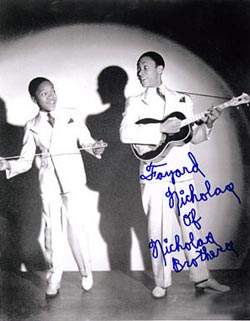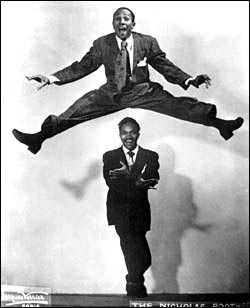Obituary
Fayard
Antonio Nicholas
(1914 - 24th January 2006)
Dancer Supreme
 The death of Fayard Nicholas the elder of the world
famous Nicholas brothers, brings to an end the story
of one of the greatest dance duos the twentieth century
had ever seen. The death of Fayard Nicholas the elder of the world
famous Nicholas brothers, brings to an end the story
of one of the greatest dance duos the twentieth century
had ever seen.
Harold (1921-2000) and Fayard Nicholas,
child prodigies from Philadelphia, built on the tradition
of brilliant African American dancers such as Bill ‘Bojangles’ Robinson,
and are the ancestors of subsequent generations of
black entertainers viewed as exceptional dancers
such as James Brown, Michael Jackson, Usher.
Bursting onto the black vaudeville scene in the 1930s,
as infants, they were so talented that despite the
heavy racial restrictions of the day, they ended
up on Broadway in musical revues and Hollywood in
musical films in record time, whilst still quite
young. Those same racial restrictions though, meant
that despite being vastly superior in range, interpretive
gifts, and technique to Fred Astaire, and having
greater flexibility and poise than Gene Kelly, in
films they were confined to a very limited arena
compared to the two white male ‘superstar’ dancers.
Fayard and Harold were literally born into show
business. Their father Ulysses ran a band at the
Standard Theatre in Philadelphia in which their mother
Viola played piano. Fayard was attending the theatre
and seeing the musicians, actors and dancers rehearsing
and performing from when he was toddler. Fayard started
out by imitating for his brother at home and other
children in their neighbourhood what he was seeing
on stage- the dancing particularly tap, the acrobatics,
the comic timing - Harold seven years younger but
very talented, started out by mimicking Fayard. They
were so good that when Fayard was 14 they made their
stage debut. They rapidly became a local sensation
appearing in theatres in Philadelphia where the manager
of the famous Lafayette theatre in New York saw them.
Their parents were encouraging, -Fayard to pursue
dance and maintained his father’s advice to
be expressive and use their arms when they danced.
By 1932, they were appearing at the internationally
famous Cotton Club in Harlem - Fayard was 17,
Harold 10 - with great artists like Cab Calloway
and Duke Ellington. What made the Nicholas brothers
so
unique was that whilst the dancing they did was rooted
in tap, they incorporated a  elements of other styles
resulting in a dazzling display of spins, twists,
leaps, and acrobatics -each brother mirroring
the other- that had never been seen before. Despite
its segregated approach Hollywood grabbed them in
the early 1930s and that decade saw them moving between
film (Pie Pie Blackbird, 1932, Kid Millions 1934,
The Big Broadcast 1936) and Broadway (in the legendary
Ziegfield Follies, and in the Blackbirds
of 1936).
In the Broadway production their sensational act
would stop the show every night, and they were eagerly
welcomed and feted in Europe, where they saw great
European ballet companies and ever innovative, incorporated
some classical ballet movements into their dance.
This approach is the reason why calling the Nicholas
brothers ‘the world’s greatest tap dancers’ is
actually to sell them short. Like many a genius child
prodigy before them, they created something unique,
a blend of various dance disciplines, tap, modern,
jazz ballet and classical ballet being the most obvious.
Georges Balanchine the great ballet choreographer
recognised immense talent when he saw it and invited
them to appear in a musical he was doing the choreography
for on Broadway. elements of other styles
resulting in a dazzling display of spins, twists,
leaps, and acrobatics -each brother mirroring
the other- that had never been seen before. Despite
its segregated approach Hollywood grabbed them in
the early 1930s and that decade saw them moving between
film (Pie Pie Blackbird, 1932, Kid Millions 1934,
The Big Broadcast 1936) and Broadway (in the legendary
Ziegfield Follies, and in the Blackbirds
of 1936).
In the Broadway production their sensational act
would stop the show every night, and they were eagerly
welcomed and feted in Europe, where they saw great
European ballet companies and ever innovative, incorporated
some classical ballet movements into their dance.
This approach is the reason why calling the Nicholas
brothers ‘the world’s greatest tap dancers’ is
actually to sell them short. Like many a genius child
prodigy before them, they created something unique,
a blend of various dance disciplines, tap, modern,
jazz ballet and classical ballet being the most obvious.
Georges Balanchine the great ballet choreographer
recognised immense talent when he saw it and invited
them to appear in a musical he was doing the choreography
for on Broadway.
In the 1940s they appeared in 6 musicals for the
studio 20th Century Fox. Their part of the films
was always something that could stand alone, not
integral to the plot or action, so that it could
be cut out of the film in order not to offend white
audiences in the southern US states. The sensational
impact they made in the films meant they were in
international demand. The Nicholas brother went on
to do tours in various parts of the world, including
South America and Europe. They appeared in front
of the King of England in 1948 at the London Palladium.
Despite this acclaim, the apartheid-like system in
their country meant that whilst working at the film
studio they could be refused admission to the in
house restaurant. It has been reported that famed
director David Selznick had to intervene and shame
the relevant restaurant head by reminding him that
it was due the brothers’ appearance in their
films, that there was a studio. Little wonder that
staying in Europe in the 1950s became more and more
attractive, and as many African Americans before
them, they found France particularly welcoming. In
1958 Fayard returned to the US leaving Harold behind
and they worked apart for seven  years. Changes in
the entertainment industry - the end of vaudeville,
a different approach to musical theatre - meant that
their form of dance was becoming less popular, but
black film stars were not yet commonplace either.
Harold was for a time married to the only black female
film star of her day - Dorothy Dandridge - but any
contacts through that and their own long involvement
in Hollywood
could not translate into chances for decent lead
or character roles. In the 1960s the brothers were
together again on US television. But the glory days
were gone and work did not reach its former heights.
In the 1970s, interest in tap dancing started to
revive. As often happens, regardless of fashion in
their own country, they had not been forgotten on
the other side of the Atlantic. First the BBC in
1985 in a programme called Cotton Club Comes
to the Ritz featured them, then Channel 4 did a documentary
in 1989 We Sing and We Dance: The Nicholas Brothers and
the same year Fayard won a Tony award for choreographing
a Broadway hit Black and Blue. years. Changes in
the entertainment industry - the end of vaudeville,
a different approach to musical theatre - meant that
their form of dance was becoming less popular, but
black film stars were not yet commonplace either.
Harold was for a time married to the only black female
film star of her day - Dorothy Dandridge - but any
contacts through that and their own long involvement
in Hollywood
could not translate into chances for decent lead
or character roles. In the 1960s the brothers were
together again on US television. But the glory days
were gone and work did not reach its former heights.
In the 1970s, interest in tap dancing started to
revive. As often happens, regardless of fashion in
their own country, they had not been forgotten on
the other side of the Atlantic. First the BBC in
1985 in a programme called Cotton Club Comes
to the Ritz featured them, then Channel 4 did a documentary
in 1989 We Sing and We Dance: The Nicholas Brothers and
the same year Fayard won a Tony award for choreographing
a Broadway hit Black and Blue.
They had lived and worked long enough to be rediscovered
and become national institutions-although they didn’t
receive the kind of financial package that gave them
the sources of income actors now have from repeat
TV showing of their films. Famous pupils such as
Debbie Allen and Janet and Michael Jackson, famous
master dancers such as Gregory Hines and Barishnikov
lauded them and a whole new generation discovered
them. Age though took its toll and arthritis in the
1980s/90s meant an end to Fayard’s flexibility
as a dancer. By the time Harold Nicholas died in
2000, they had appeared before nine US presidents,
a star on the Hollywood walk of fame, and an honorary
doctorate from Harvard. A special concert was staged
in their honour at Carnegie Hall in 1998.
The Nicholas Brothers’ legacy lives on in the
fantastic, gravity defying movements of those who
have mastered various forms of African-American modern
dance including breakdancing.
Marsha Prescod
|




